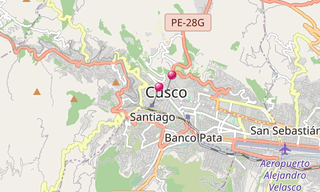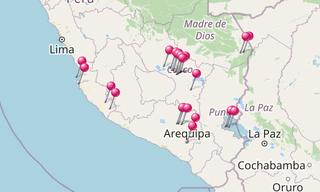Cusco is the historic capital of the Inca Empire located in the south-eastern Peru, near the Urubamba Valley (Sacred Valley) of the Andes mountain range. According to an Inca legend, the city was founded by Manco Capac in the 12th century and received its shape from Pachacuti Inca Yupanqui (Pachacútec) who transformed the Kingdom of Cusco into a vast empire.
The Fiestas Patrias Peruanas, or Peruvian National Holidays, are celebrations of Peru's independence from the Spanish Empire. They officially consist of two days: July 28, in commemoration of Peru's Independence won by José de San Martín, and July 29, in honor of the Armed Forces and the National Police of Peru.
The celebration of Fiestas Patrias in Peru coincides with the vacation periods for the local schools as well as some businesses. Along with Christmas, Fiestas Patrias is one of the most important celebrations of the year for Peruvians and it is normal for local businesses to generate as much revenue as in the month of December.
Arco de Santa Clara
The Arco de Santa Clara is a triumphal arch built in one of the vertices of Plaza San Francisco in the historic center of the city of Cusco. It is a monument considered the most beautiful triumphal arch in Peru.
Cathedral (With Iglesia del Triunfo and Iglesia de Jesus Maria)
The Cathedral Basilica of the Assumption of the Virgin (Catedral Basílica de la Virgen de la Asunción) is the main church of the Roman Catholic Archdiocese of Cusco. The cathedral is located on the Plaza de Armas. The entire building was built between 1560 - 1654 on the foundations of Kiswarkancha (the Inca palace of Viracocha). It is shaped like a Latin cross. Adjacent and joined to the cathedral is the smaller Iglesia del Triunfo, the first Christian church to be built in Cusco
Coricancha (Temple of the Sun)
Coricancha (The Golden Temple) was the most important temple in the Inca Empire. Most of the temple was destroyed after the 16th century war with the Spanish conquistadors, as settlers also took it apart to build their own churches and residences. Much of its stonework was used as the foundation for the 17th century Santo Domingo Convent.
It was built after the 1650 earthquake destroyed the first Dominican convent. To construct the Coricancha, the Inca used ashlar masonry, building from the placement of similarly sized cuboid stones that they had cut and shaped for this purpose. Pachakutiq Inca Yupanqui rebuilt Cusco and the Temple of the Sun, enriching it with more oracles and edifices, and adding plates of fine gold.
He provided vases of gold and silver for the Mama-cunas, nuns or cloistered women, to use in the veneration services. Finally, he took the bodies of the seven deceased Incas and adorned them with masks, head-dresses, medals, bracelets, and sceptres of gold, placing them on a golden bench.
The walls were once covered in sheets of gold, and the adjacent courtyard was filled with golden statues. When the Spanish in 1533 required the Inca to raise a ransom in gold for the life of their leader Atahualpa, most of the gold was collected from Coricancha.
Iglesia de la Compañía
The Church of the Society of Jesus (Iglesia de la Compañía de Jesús) is a historic Jesuit church in Cusco. It is situated in the Plaza de Armas, the city center. The construction of the original church was begun in 1576 on the grounds of the old Amarucancha, palace of the Inca Huayna Cápac that was one of the largest palaces surrounding the main square of Qosqo (the Inca capital).
In the year 1650, the main church was devastated by the earthquake. It was rebuilt by the Flemish Jesuit and architect, Jean-Baptiste Gilles, the works on the façade were directed by Diego Martínez de Oviedo. In the church, there are paintings and sculptures by Diego de la Puente, Marcos Zapata, and Cristo de Burgos.
Iglesia San Francisco de Asís
The church of Saint Francis of Assisi is a Franciscan church built in the city of Cusco. It is located on the south side of Plaza San Francisco, in the center of the city. The arrival of the Franciscan friars to Cusco occurred a few years after its Spanish foundation.
In 1534 they settled on land in the north of the city. In 1538, the church was moved to the Plaza de Armas of Cusco and was located on the northwestern side of it in the ancient Inca palace of Qasana. Finally in 1549 they settled on the land that they still occupy today about 300 m southwest of the Plaza de Armas.
In 1572, Viceroy Francisco de Toledo during his visit to the city of Cusco ordered that a Church dedicated to Saint Francis of Assisi be built on the land occupied by the Franciscans.
Iglesia de San Pedro
The church of Saint Peter is a Catholic church located in the city of Cuzco. The church is built on what was the Hospital de Naturales del Cusco founded in 1556.
Plaza de Armas
The Plaza de Armas del Cuzco is located in the historic center of the city, it has been the main public space in the town since before its Spanish foundation in 1534. Geological studies show that a swamp originally existed there, crossed by the Saphy River.
During the Inca empire this swamp was dried and transformed into the administrative, religious and cultural center of the imperial capital. There all kinds of ceremonies were held and the victories of the Inca army were celebrated. After the Spanish conquest, it was transformed into a plaza by the new rulers, who built Catholic temples and mansions on the ruins of the ancient Inca palaces.
In this square, Túpac Amaru II was executed in 1781 as well as the cacique Bernardo Tambohuacso, Mateo Pumacahua and several other heroes of the independence of Peru.
San Pedro Market
The Central Market of San Pedro is the main and oldest food market in the city of Cusco, and is located in its historic center in front of Plazoleta San Pedro and Santa Clara street whose current route corresponds to the ancient Inca trail starting from Huacaypata.

.hero.landscape.jpg?w=1600)


-Plaza-de-Armas.jpg?w=256)
-Plaza-de-Armas.jpg?w=256)
-Plaza-de-Armas.jpg?w=256)
-Plaza-de-Armas.jpg?w=256)
-Iglesia-de-San-Pedro.jpg?w=256)
.jpg?w=256)
.jpg?w=256)
-Iglesia-de-la-Compania-de-Jesus.jpg?w=256)
.jpg?w=256)
-Iglesia-de-la-Compania-de-Jesus.jpg?w=256)
-Plaza-de-Armas.jpg?w=256)
.jpg?w=256)
.jpg?w=256)
-Iglesia-de-la-Compania-de-Jesus.jpg?w=256)
-Plaza-de-Armas.jpg?w=256)
-Plaza-de-Armas.jpg?w=256)
-Plaza-de-Armas.jpg?w=256)
-Plaza-de-Armas.jpg?w=256)
-Plaza-de-Armas.jpg?w=256)
-Plaza-de-Armas.jpg?w=256)
-Plaza-de-Armas.jpg?w=256)
-Catedral-del-Cuzco.jpg?w=256)
-Iglesia-de-la-Compania-de-Jesus.jpg?w=256)
-Plaza-de-Armas.jpg?w=256)
.jpg?w=256)
-Plaza-de-Armas.jpg?w=256)
-Iglesia-de-la-Compania-de-Jesus.jpg?w=256)
.jpg?w=256)
-Plaza-de-Armas.jpg?w=256)
-Iglesia-de-la-Compania-de-Jesus.jpg?w=256)
-Iglesia-de-la-Compania-de-Jesus.jpg?w=256)
-Plaza-de-Armas.jpg?w=256)
-Plaza-de-Armas.jpg?w=256)
-Iglesia-de-la-Compania-de-Jesus.jpg?w=256)
-Plaza-de-Armas.jpg?w=256)
-Plaza-de-Armas.jpg?w=256)
.jpg?w=256)
-Iglesia-de-la-Compania-de-Jesus.jpg?w=256)
-Plaza-de-Armas.jpg?w=256)
-Plaza-de-Armas.jpg?w=256)
.jpg?w=256)
-Plaza-de-Armas.jpg?w=256)
.jpg?w=256)
-Iglesia-de-la-Compania-de-Jesus.jpg?w=256)
.jpg?w=256)
-Iglesia-de-la-Compania-de-Jesus.jpg?w=256)
-Plaza-de-Armas.jpg?w=256)
-Arco-de-Santa-Clara.jpg?w=256)
-Plaza-de-Armas.jpg?w=256)
-Plaza-de-Armas.jpg?w=256)
-Plaza-de-Armas.jpg?w=256)
.jpg?w=256)
-Iglesia-de-San-Pedro.jpg?w=256)
-Plaza-de-Armas.jpg?w=256)
-Plaza-de-Armas.jpg?w=256)
-Plaza-de-Armas.jpg?w=256)
-Plaza-de-Armas.jpg?w=256)
-Iglesia-de-la-Compania-de-Jesus.jpg?w=256)
-Plaza-de-Armas.jpg?w=256)
-Plaza-de-Armas.jpg?w=256)
.hero.jpg?w=320)

.hero.jpg?w=320)
.map.png)